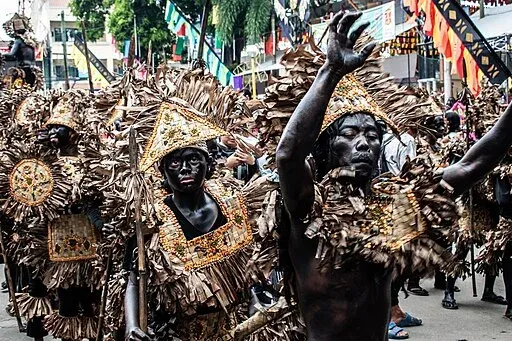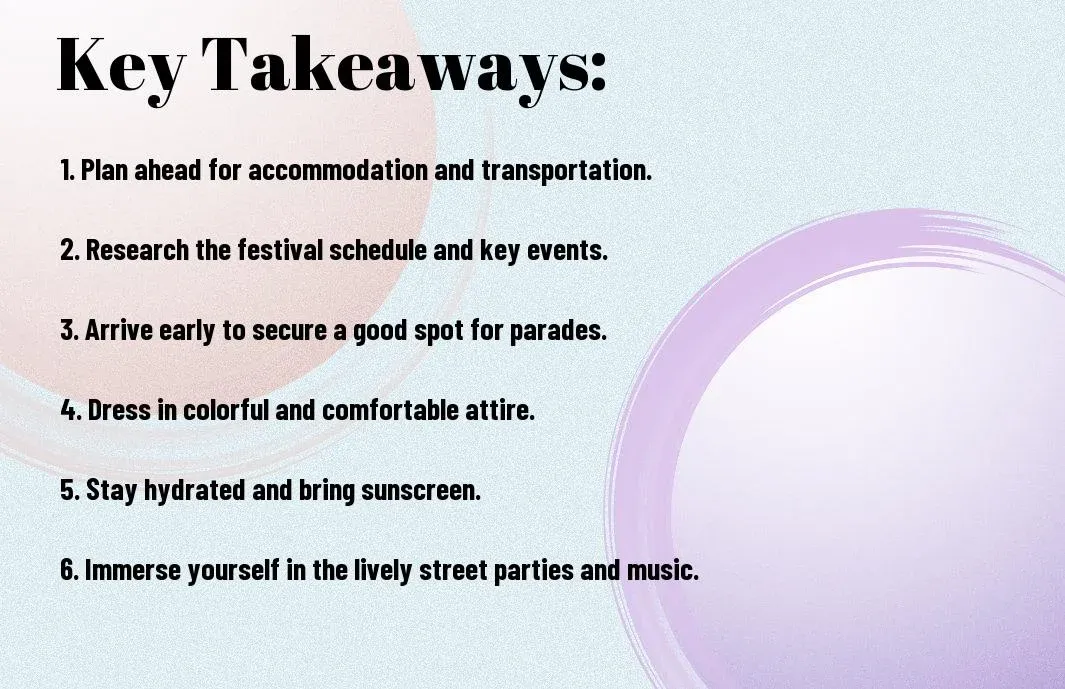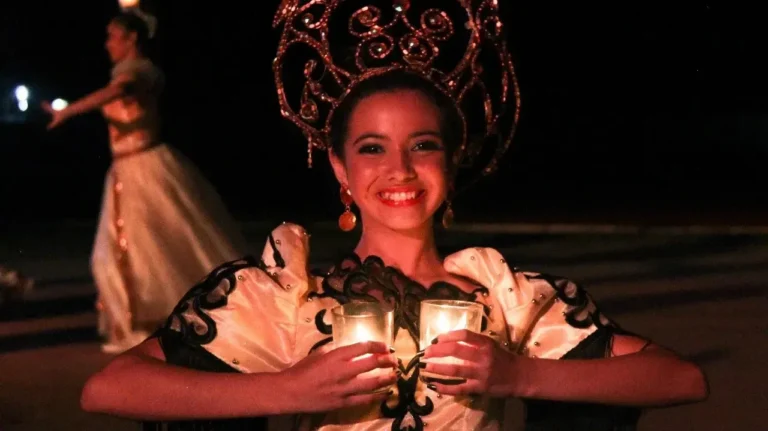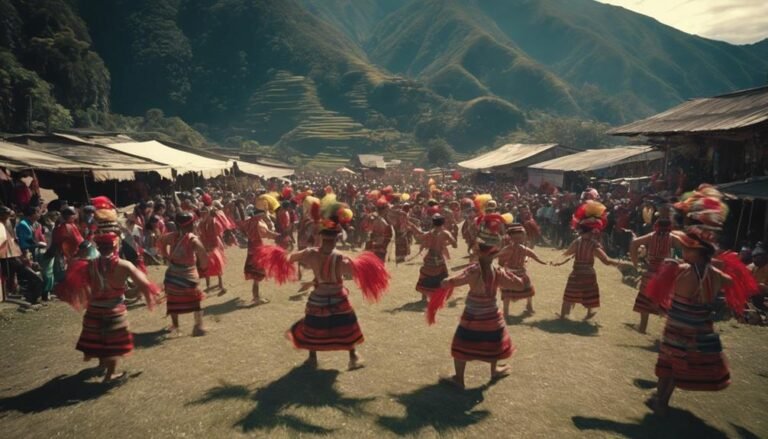11 Tips for Navigating Ati-Atihan Festival Philippines Schedule & Events

Image Source: Elisolidum, CC BY-SA 4.0, via Wikimedia Commons
Embark upon the vibrant and exhilarating journey of the Ati-Atihan Festival with confidence and ease.
As one of the most phenomenal and thrilling festivals in the Philippines, Ati-Atihan offers a whirlwind of activities and events that can be overwhelming for first-time attendees.
To ensure that you make the most out of your experience, here are 11 essential tips for navigating the Ati-Atihan Festival schedule and events.
From the highlight of the festival, the procession of Sto. Nino, to the various street dancing competitions and cultural exhibitions, this guide will help you plan your itinerary and make the most of every moment at this epic and unforgettable celebration.

Facts About Ati-Atihan Festival Philippines
| Facts | Explanation |
|---|---|
| Name of the Festival | Ati-Atihan Festival |
| Type of Festival | Cultural, Religious |
| Festival Etymology | The term “Ati-Atihan” means “to be like Aetas” or “to make oneself like an Aeta.” It refers to the indigenous Aeta people of the Philippines. |
| Date when it was celebrated first | January 16, 1200 |
| Founder of the Festival | Unknown (traditionally attributed to Mariano “Moy” Loyola) |
| Brief History of the Festival | The Ati-Atihan Festival traces its origins back to the 13th century when a group of Malay chieftains fled from Borneo and sought refuge in the island of Panay in the Philippines. They encountered the native Aeta tribe, who welcomed them by smearing soot on their faces and dancing in celebration. This encounter led to the fusion of cultures, and the festival was born. Today, the festival is a vibrant and colorful event that showcases the rich cultural heritage of the Aeta and Malay people through street dancing, music, and elaborate costumes. It is also a religious festival honoring the Santo Niño (Child Jesus). |
| Brief History of the City | Kalibo, the city where the Ati-Atihan Festival is celebrated, is the capital of Aklan province in the Philippines. It was founded in 1956 and has a long history dating back to pre-colonial times. The city played a significant role in trade and commerce during Spanish colonization and has since become a bustling hub for tourism and agriculture. Kalibo is known for its warm hospitality, beautiful beaches, and vibrant festivals such as the Ati-Atihan. It is also the gateway to the famous Boracay Island. |
| Ethnic Information | – The festival celebrates the indigenous Aeta people and their cultural heritage. – It also incorporates elements of Malay culture brought by the early settlers from Borneo. |
| Location of the City in the Country | Kalibo is located in the western part of the island of Panay in the Philippines. |
| How to reach the city | By Air: Kalibo International Airport is the main gateway to the city. It serves both domestic and international flights. By Sea: Kalibo also has a port that connects it to other islands in the Philippines. By Land: Kalibo is accessible by bus or private vehicle from other major cities in Panay Island or via ferry from Caticlan, which is near Boracay Island. |
| Nearby and Surrounding Cities/Towns | – Caticlan (gateway to Boracay Island) – 68 km – Iloilo City – 85 km – Roxas City – 75 km – Antique Province – 55 km – Pandan – 45 km – Numancia – 10 km – New Washington – 15 km – Banga – 20 km – Batan – 25 km – Libacao – 30 km – Madalag – 35 km – Tangalan – 25 km – Lezo – 15 km – Ibajay – 30 km – Nabas – 35 km – Malay – 60 km – Buruanga – 65 km |
| Google Map Link | Kalibo City on Google Maps |
| Festival Main Events and Activities | – Street Dancing Competition – Parades – Traditional music and dance performances – Food and craft fairs – Religious processions honoring Santo Niño – Fireworks display – Cultural exhibitions and demonstrations – Beauty pageants and coronations – Live music concerts and performances – Traditional games and sports events – Street parties and nightlife celebrations – Costume contests – Cultural shows and theater productions |
| Other Famous Tourist Attractions | – Bakhawan Eco-Park – Museo it Akean (Aklan Museum) – Jawili Falls – Sampaguita Gardens Resort – Tigayon Hill and Cave – Aklan Freedom Shrine – Museo it Kalibo – Cathedral of St. John the Baptist – Kalibo Belfry Tower – Pastrana Park – Kalibo Plaza Gazebo – Pina Weaving Centers – Andagao Beach – Ariel’s Point (nearby in Buruanga) |
| Famous Food Dishes of the City | – Inubarang Manok (Chicken Stew with Coconut Milk) – Kinilaw (Raw Fish Salad) – Linapay (Fish Soup) – Binakol (Chicken Soup with Coconut Water) – Inihaw na Barbecue (Grilled Skewered Meat) – Lechon Baboy (Roasted Pig) – Biniribid (Rice Cake) – Latik (Coconut Sugar Syrup) |
| Landmarks in the City | – Kalibo Cathedral (Cathedral of St. John the Baptist) – Bakhawan Eco-Park Boardwalk – Museo it Akean (Aklan Museum) – Kalibo Belfry Tower – Pastrana Park Fountain – Museo it Kalibo (Aklan Freedom Shrine Museum) |
| Why they are famous | – Kalibo Cathedral: One of the oldest churches in Panay Island, known for its Spanish colonial architecture and religious significance. – Bakhawan Eco-Park Boardwalk: A mangrove forest conservation area with a scenic wooden boardwalk, perfect for nature walks and birdwatching. – Museo it Akean: Showcases Aklan’s rich cultural heritage through its exhibits on history, art, and traditional crafts. – Kalibo Belfry Tower: An iconic landmark that stands as a remnant of Kalibo’s colonial past. – Pastrana Park Fountain: A popular gathering spot in Kalibo’s central plaza, surrounded by lush greenery and beautiful flowers. – Museo it Kalibo (Aklan Freedom Shrine Museum): Commemorates the province’s role in the fight for independence with its displays of Aklanon heroes and historical artifacts. |
| Related Festivals in the Same Region | – Sinulog Festival (Cebu City) – Dinagyang Festival (Iloilo City) – Pintados Festival (Tacloban City) – Kadayawan Festival (Davao City) – Panagbenga Festival (Baguio City) |
Preparing for Ati-Atihan
If you’re planning to attend the Ati-Atihan festival, there are a few essential things you should consider before you travel.
Ati-Atihan is a lively and colorful event, and being prepared will ensure that you have the best experience possible. Here are some tips to help you get ready for the festivities.
Best Times to Attend
When it comes to attending Ati-Atihan, the best time to go is during the third weekend of January.
This is when the main events, including the street dancing and parades, take place. The celebrations typically kick off on Saturday and continue through Sunday, so make sure your visit coincides with these dates to experience the full spectacle of the festival.
What to Wear and Bring
Attending Ati-Atihan means being part of the colorful and vibrant atmosphere, so it’s recommended that you wear bright and festive clothing.
Consider bringing a traditional headdress or a mask to join in the fun. As you will be spending a lot of time outdoors, it’s important to bring sunscreen, a hat, and a reusable water bottle to stay hydrated throughout the day.
Don’t forget to also bring a small bag to carry your essentials and some extra cash for food, drinks, and souvenirs.
The Ati-Atihan Schedule
The Ati-Atihan Festival is a vibrant and lively event that lasts for several days. The schedule is filled with various activities, parades, and religious rituals that you won’t want to miss.
Understanding the schedule and key events will help you make the most of your Ati-Atihan experience.
Key Events and Activities
During the Ati-Atihan Festival, there are several key events and activities that you should prioritize. The Opening Salvo marks the beginning of the festival and usually takes place on the first Friday of January.
This is followed by the Ati-Atihan Contest, where different groups compete in street dancing and elaborate costumes. Another important event is the Religious Procession, which honors the Santo Niño and is a significant aspect of the festival’s religious roots.
Additionally, don’t miss out on the Fireworks Display and the Trade Fair, where you can experience the local culture and sample authentic Ati-Atihan delicacies.
Day-to-Day Breakdown
Throughout the festival, each day offers a unique experience. On the first day, you can expect the streets to come alive with colorful costumes and drum beats as the opening salvo kicks off the celebrations.
The following days are filled with vibrant street parades, live music, and various cultural performances. The highlight of the festival is usually on the third day, which culminates in the grand finale of the Ati-Atihan Contest and the religious procession.
Navigating the Festival
To fully enjoy and make the most out of the Ati-Atihan Festival, navigating through the bustling streets and packed venues is crucial. Here are some tips to help you seamlessly navigate the festival grounds and make the most of your experience.
Transportation and Accommodation Tips
When attending the Ati-Atihan Festival, it’s essential to plan your transportation and accommodation. The festival draws large crowds, so securing a place to stay and arranging transportation can be challenging.
Book your accommodations well ahead of time to ensure you have a place to stay amidst the surge of visitors. Additionally, consider staying close to the festival venue to minimize travel time. When it comes to transportation, be prepared for heavy traffic and limited parking.
Consider using public transportation or walking to the festival to avoid the hassle of finding a parking spot. It’s also a good idea to have a backup plan in place, such as using ride-sharing services, in case of transportation delays.
Knowing your transportation and accommodation options in advance will help you avoid unnecessary stress during the festivities.
Safety and Etiquette Guidelines
As you navigate through the festival crowds, it’s important to prioritize safety and observe proper etiquette. Keep an eye on your belongings at all times, as large crowds can create opportunities for pickpocketing.
Avoid displaying excessive amounts of cash or valuables and be mindful of your surroundings. It’s also crucial to respect the local customs and traditions during the festival.
Be polite and considerate towards other attendees, and always ask for permission before taking photos, especially of the costumed performers.
By observing these safety and etiquette guidelines, you can ensure a smooth and enjoyable experience at the Ati-Atihan Festival.
What Are Some Tips for Getting the Most Out of Sinulog Festival in Cebu?
If you’re planning to attend the Sinulog Festival in Cebu, here are some sinulog festival tips to make the most of your experience. Arrive early to secure a good spot for the parade, stay hydrated throughout the day, and immerse yourself in the vibrant energy and culture of the festival. Don’t forget to wear comfortable footwear for all the dancing and walking!
Immersing in the Ati-Atihan Experience
Lastly, immersing yourself in the Ati-Atihan experience is the best way to fully appreciate this vibrant and colorful festival. It’s an opportunity for you to not only witness but also actively participate in the festivities that make Ati-Atihan truly unique.
From the energetic street dancing to the must-see performances and rituals, here’s how you can make the most of your Ati-Atihan experience.
Participating in the Street Dancing
One of the most exhilarating ways to immerse yourself in the Ati-Atihan experience is by joining the street dancing. In this lively and chaotic parade, you’ll have the chance to dance alongside the locals and other festival-goers, covered in vibrant face and body paint.
The energy is infectious, and the pulsating beats of the drums will invigorate your spirit. However, it’s important to be cautious and aware of your surroundings as the crowded streets can get unpredictable.
Remember to stay close to your group and keep an eye on your belongings. Keep hydrated and pace yourself to avoid exhaustion as the dancing can be physically demanding.
Must-See Performances and Rituals
Amidst the exhilarating street dancing, don’t miss out on the captivating performances and intriguing rituals that take place throughout the festival.
Make sure to catch the traditional Ati-Atihan mass held at the Kalibo Cathedral, where you can witness the fusion of Catholic and indigenous Ati traditions.
The tribal competition at the stadium is also a must-see, featuring awe-inspiring performances by different Ati-Atihan tribes. Witnessing the ancient rituals and religious processions will give you a deeper understanding of the cultural significance of the festival.
Be respectful of the local traditions and customs as you observe these performances and rituals, and refrain from intruding on sacred ceremonies.
Beyond the Ati-Atihan
Despite the grandeur of the Ati-Atihan festivities, there’s more to explore beyond the well-known parade and street performances.
After immersing yourself in the vibrant energy of the festival, take the opportunity to discover the hidden gems of Kalibo and indulge in the local culture and cuisine.
Exploring Kalibo and Nearby Attractions
Once the festival fervor has settled down, you can take some time to explore Kalibo and its nearby attractions.
Visit the Aklan Freedom Shrine to learn about the historical significance of the region, or take a stroll through the Kalibo Pastrana Park to soak in the tranquil atmosphere.
Additionally, you can venture out to Jawili Falls and enjoy the natural beauty of the cascading waterfalls and lush surroundings.
These experiences will allow you to immerse yourself in the rich history and natural wonders of the area.
Culinary Journey: Sampling Local Delicacies
Indulge in a culinary adventure as you sample the local delicacies that Kalibo has to offer.
From the savory flavors of chicken Inasal to the mouthwatering sweetness of Binakol, you’ll have the opportunity to savor the authentic tastes of Aklanon cuisine.
Don’t miss the chance to visit the vibrant Kalibo Public Market, where you can feast your eyes on an array of fresh produce and regional delicacies. Trying out these local dishes will allow you to appreciate the rich and diverse gastronomic heritage of the region.
Summary Of Ati-Atihan Festival Philippines
| Festival Name | Ati-Atihan Festival |
|---|---|
| Official Name | Kalibo Santo Niño—Ati-Atihan Festival |
| Also Called | Ati-Atihan |
| Observed by | Kalibo, Aklan |
| Type | Religious / Cultural |
| Date | Third Sunday in January |
| 2022 Date | January 16 |
| 2023 Date | January 15 |
| 2024 Date | January 21 |
| 2025 Date | January 19 |
| Frequency | Annual |
| Location | Several towns of the province of Aklan, Panay Island |
| Biggest Celebration | Town of Kalibo, the province’s capital |
| Meaning of Ati-Atihan | “to imitate the Ati people” |
| Significance | Mother of All Philippine Festivals |
| Processions and Street-parades | Yes |
| Showcasing themed floats | Yes |
| Dancing groups | Yes |
| Colorful costumes | Yes |
| Marching bands | Yes |
| Face and body paints | Yes |
| Street parade known as Sadsad (local term) | Yes |
| Festivals inspired by Ati-Atihan | Dinagyang of Iloilo, Sinulog of Cebu |
| Other towns celebrating Ati-Atihan | Ibajay, Lezo, Malinao, Makato, Batan, Altavas, Malay (Boracay Island) |
| Related festivals in the region with similar themes | Dinagyang of Iloilo, Halaran of Capiz, Binirayan of Antique |
For more information, you can visit the following links:
Conclusion
Now that you have familiarized yourself with the 11 tips for navigating the Ati-Atihan Festival’s schedule and events, you are well-equipped to make the most of your experience.
By planning, being flexible, and immersing yourself in the vibrant culture, you can ensure that you don’t miss out on any of the festival’s highlights.
Whether you’re attending religious processions, street parties, or vibrant parades, these tips will help you navigate the festival with ease and make the most of your time in the Philippines.




